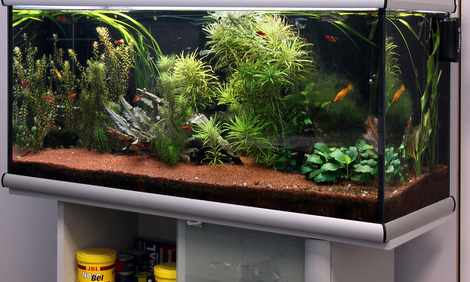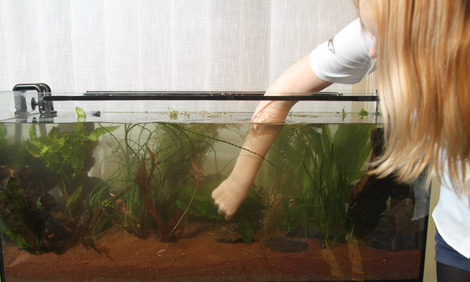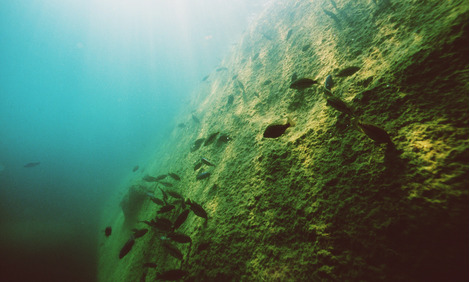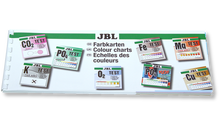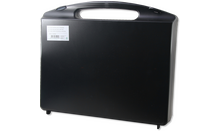Having set up your marine aquarium the water values need to be measured between daily and weekly, to find out how well the aquarium is developing and when it is ready for the animals to be added. The carbonate hardness indicates the pH stability of the water. It should be between 7 and 10 °dKH. Ammonium is the first stage of the nitrogen decomposition and it increasingly changes into toxic ammonia with pH values above 7. The ammonium content must not exceed 0.25 mg/l. The nitrite value indicates whether this toxic compound for fish is present in the aquarium. Nitrite should always have a level below 0.2 mg/l. Nitrate and phosphate serve as food for algae. Nitrate values over 20 mg/l and phosphate values over 0.1 mg/l can lead to excessive algae growth. Many coral species grow significantly better with low nitrate and phosphate amounts since endosymbiotic algae (zooanthellae) live in their tissues.
You can analyse your measured water values in the JBL Online Laboratory free of charge and receive recommendations.
Products & Shop
JBL Test Combi Set Marin
Starter test case for marine aquariums
PROAQUATEST COMBISET Marin
- 6 water tests to easily and precisely determine the most important water values in marine water, especially for fish aquariums
- Add colour indicator and compare on colour chart or count the drops until the colour changes
- Contains tests for carbonate hardness, pH value, ammonium/ammonia, nitrite, nitrate and phosphate
- Comparator system facilitates the colour comparison and takes the inherent water colouring into account
- Contents: 6 water tests, comparator block, 3 cuvettes, syringe, measuring spoon, colour charts, analysis record sheets and instructions
You may also be interested in
JBL Test Combi Set Marin
Properties
| Animal species: | Corals, Gobies, Mussels, Snails |
| Animal size: | For all animal sizes |
| Animal age group: | All aquarium fish |
| Volume habitat: | For all aquariums |
| Colour: | multicoloured |
| Dosage: | see instruction manual |
Electronic label / illuminant
| Mercury: | No |
| Dimmable: | No |
Have you lost your record sheets, already filled them all in or do you need them in another language?
With the following links you can quickly and easily print out your new record sheets with recommendations for the individual parameters at home and document the water analyses.
deutsch: https://www.jbl.de/?lang=de&mod=files&func=show&id=11164
English: https://www.jbl.de/?lang=en&mod=files&func=show&id=11164
französisch: https://www.jbl.de/?lang=fr&mod=files&func=show&id=11164
niederländisch: https://www.jbl.de/?lang=nl&mod=files&func=show&id=11164
The colour cards are not available for download on the JBL website. The absolutely accurate colour reproduction that is required can only be achieved using a printer which can be re-calibrated before each printout. Most privately used printers are not accurate enough for this.
You will find the colour chart bundle as a spare part on the respective product page and in the spare parts shop under: https://www.jbl.de/en/products/detail/8732/jbl-proaquatest-assortiment-color-chart
The tests from the test range: JBL GH test, JBL KH test, JBL calcium test Ca and JBL magnesium test Mg, where the number of drops are counted until the colour changes and the counted value is multiplied by a value:
GH = number of drops = general hardness in °dH
KH = number of drops = carbonate hardness in °dH
CO2 = number of drops * 2 = CO2 in mg/l
Magnesium + calcium = number of drops * 120 = amount Ca + Mg in mg/l
Calcium = number of drops * 20 = amount Ca in mg/l
Magnesium = amount Ca+Mg from magnesium test - amount Ca in mg/l = magnesium in mg/l
The colour charts are intended to be used with the comparator block. In addition, when the comparator block is used with the blank water sample, this compensates the inherent water colour.
Therefore, if the comparator block is not used, there will most likely be deviations in the readings.
We repeatedly receive questions regarding the symbols on the water test. The hobby areas cannot be clearly assigned to the scales for analysis. There are three symbols to make the hobby areas on the colour charts clear:
Discus = fresh water
Emperor = salt water
Koi = garden pond
In the following, you will find a list which assigns the scale for analysing the results from measurements in the hobby area and explains the symbols: The scales are described from the top to the bottom here.
NO3: salt water, fresh water, garden pond
pH 6.0 – 7.6: fresh water, garden ponds
pH 7.4 – 9.0: salt water, fresh water, garden pond
Fe: fresh water, garden pond
The following JBL tests have a uniform scale for all 2 or 3 hobby areas for analysis of the results from the measurements, as differentiation is no longer necessary:
SiO2
Cu
NH4
NO2
PO4
pH 3-10
O2
If one of your measurements reaches the end of the colour chart scale you can multiply the scale by diluting later tests with distilled water (e.g. JBL Dest).
Here’s how to do it: dilute the sample with distilled water and carry out the test once more.
This works in detail as follows:
GH test: Instead of 5 ml use 10 ml aquarium water. Now 1 drop is equivalent to 0.5 dGH.
KH test: Instead of 5 ml use 10 ml aquarium water. Now 1 drop is equivalent to 0.5 dGH.
Note: when using 10 ml sample water the colour development is weaker with the first drops than with 5 ml sample water. Put the measuring container on a white underlay for a better readability.
NH4/NH3 ammonium/ammonia, NO2 nitrite, Fe iron and Cu copper:
2.5 ml sample + 2.5 ml dist. water: result times 2
1 ml sample + 4 ml dist. water: result times 5
0.5 ml sample + 4.5 ml dist. water: result times 10
NO3 nitrate, SiO2 silicate, PO4 phosphate sensitive and Mg magnesium freshwater:
5 ml sample + 5 ml dist. water: result x 2
2 ml sample + 8 ml dist. water: result x 5
1 ml sample + 9 ml dist. water: result x 10
PO4 phosphate koi high range:
2.5 ml sample + 2.5 ml dist. water: result x 2
1 ml sample + 4 ml dist. water: result x 5
K potassium:
7.5 ml sample + 7.5 ml dist. water: result x 2
3 ml sample + 12 ml dist. water: result x 5
1.5 ml sample + 13.5 ml dist. water: result x 10
K potassium in marine water:
1. Fill 10 ml of sample water with distilled water to 300 ml.
2. Follow the instructions for fresh water.
3. Multiply the test result by a factor of 30.
CO2 direct, Ca calcium and Mg+Ca magnesium+calcium: not required.
Basically a sealed test keeps longer than an open one. How much the shelf life is reduced depends crucially on the handling and the storage conditions of the reagents. It may happen that a reagent in a test that has been open for 9 months doesn’t indicate correctly any more. However, additional information is needed to answer this question properly.





